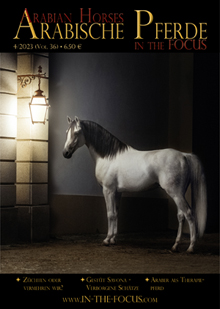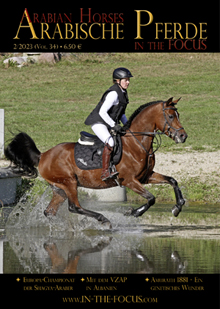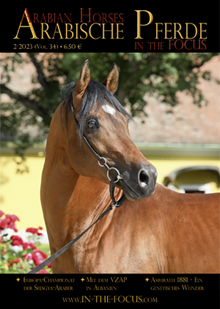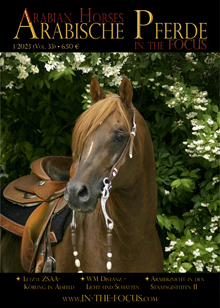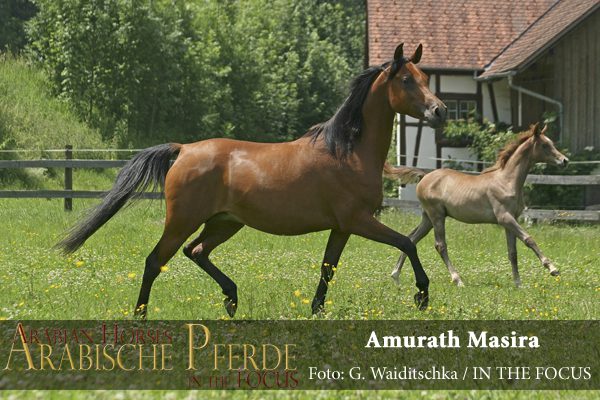
Even though it has been a few months, the pain is still deep in breeder Bernd Zimmermann about the loss of his mare Amurath Masira (Dahab / Mahara) * 2001, who died shortly after the birth of her foal. On Masira, daughter Lena had learned to ride, she was Gabi Zimmermann’s darling, and for Bernd Zimmermann, she was riding and broodmare with a very consistent inheritance. “As a leading mare, she was not as confident as her mother, but much more patient with other herd members,” he describes her. “Foals, also of other mares, were always under special protection with her. She was kind and stubborn at the same time – a heritage of Karmin -, soft and yet very spirited, iron-hard and tough to the last second.” He continues: “Masira and I had a slightly complicated relationship, we liked each other and could always rely on each other, maybe it was not the great love, but I valued her as a riding horse and broodmare, and breeding with her was very easy, no matter whether in purebred Arabian or Trakehner breeding, the prognosis for the expected foal was relatively easy to come in. Masira was not immaculate on her legs, but very dry, and her heredity was excellent, as all the foals had very good hooves and joints, correct movement and very good angulations.”
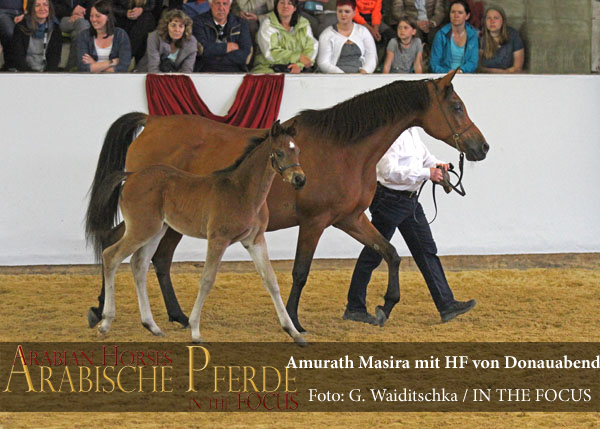
Amurath Masira’s dam Mahara (Gharib / Magda) * 1980 was the first Arabian horse of the Zimmermann family and a foundation mare of their breeding program. And although Masira’s sister Amurath Morgana (by Monrad) eventually left more offspring in the stud farm, Amurath Masira (by Dahab) was still an important pillar for the Zimmermanns, with whom they also ventured a trip to the Trakehner breed. She left a total of nine foals, including only two purebred Arabian mares – but both premium mares! – Amurath Mahabbah and Amurath Mahiba.
Amurath Mahibah (by Gazwan Al Nasser) * 2011 should remain in Gestüt Amurath for the time being. “And as it sometimes happens, already her first foal, Amurath Malyah (by Psyrasic) * 2017 was a blast,” enthuses Bernd Zimmermann. Since Masira was still fit and healthy in 2017 and had become pregnant without problems, the Zimmermanns decided to sell Amurath Mahibah – after all, they still had Amurath Malyah as another option of that dam line.
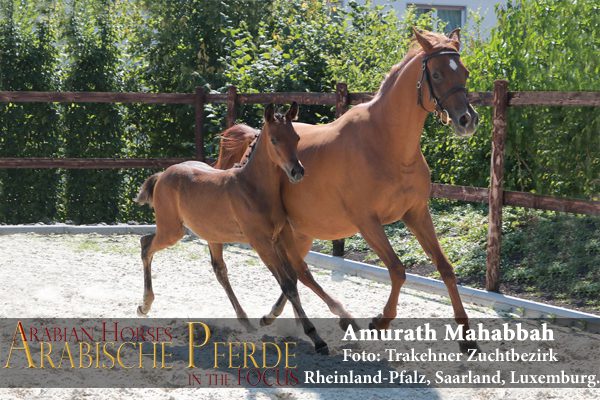
Also, Masira’s daughter Amurath Mahabbah was sold, namely to a friend, the purebred Arabian and Trakehner breeder, Annette Schnaufer. She used her – due to her size (158 cm) and her frame – as a broodmare for the Trakehner breed (half-breeds for versatility). Mahabbah had two very good colts (2017 by Abendtanz and 2018 by Helium). “The colt by Helium was one of the highest-rated half-bred-foals in Germany in 2018. He is absolutely top-class. He is brown, very elegant and full of character, almost flawless in his conformation and very much shaped by Masira,” enthuses Bernd Zimmermann. “After the loss of Masira, Mahabbah was given as a present by Mrs. Schnaufer and is back with us today. That’s no self-evident gesture.”
The performance-tested mare Masira was also used in the Trakehner breed and had in 2017 a colt by Donauabend. Now, it is well known that it is difficult to have a stallion with 50% Arabian blood licensed in the Trakehner breed, so the joy about the filly born in 2019, also by Donauabend, was correspondingly high, because in this way it is easier, to introduce Arabian blood into the Trakehner breed.
Bernd Zimmermann explains why he choose Donauabend: “This stallion has many advantages in his conformation and he is not too heavy for an Arabian mare. His sireline is full of excellent jumping blood and I love the horses similar to ‘Habicht’.” Donauabend tails back in his sireline to Habicht, which in turn originates from the Siglavy db strain (see AP 1/2019, p. 53). Donauabends dam tails back to the damline of the Weil mare Murana 1808.
“Donauabend is a late-maturing stallion that gets better year by year,” explains Bernd Zimmermann. “As can be seen, he inherits very consistently and has an excellent interior. These advantages and in comparison to the conformation of both horses, caused me to make the mating twice. The aim was a very typical, correct, dry horse for eventing, and Annette Schnaufer was in both cases the grateful customer of the foals. Raising these foals at the State Stud Marbach and further promotion is agreed between us and is exemplary. The filly of 2019, now, unfortunately, an orphan foal, got the name ‘Masira’s Last Gift’ by Annette Schaufer. This foal is indeed a present for all of us: Black Brown with no signs and a ‘Trakehner’ edition of her dam: Fine and noble, very elegant and with strong movements. The further development remains to be seen, but it would be nice to see a Trakehner line establishing here – but that’s a very long way … “.
After Masira died one day after giving birth, good advice was needed. Masira’s Last Gift is now growing at the Otte Farm in Lower Saxony, which specializes in orphan foals. At six months, Masira’s Last Gift will move to St. Johann, where she will be raised the next years.
So they still do exist, the “old types” of the purebred Arabian, horses that can certainly be used in warmblood breeding, especially in Trakehner breeding, of course. With Masira, the last mare of “Weil-Marbacher” descent on her sire and dam side at the Amurath stud died, and thus unfortunately also a representative of these “old types”, which are becoming increasingly rare.
Gudrun Waiditschka









